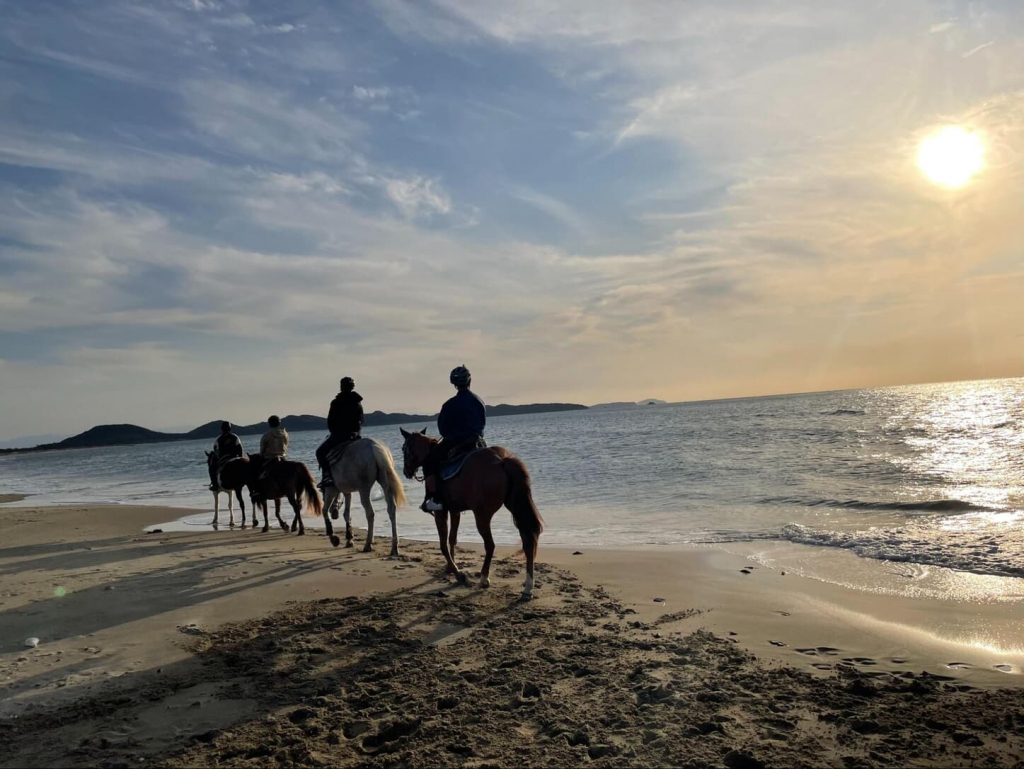Kyushu’s northernmost prefecture is often travelers’ first stop when they arrive in the region. Usually, a trip will include a night or two in Fukuoka City before heading to neighboring prefectures. But for your next trip, head outside the capital to see what Fukuoka Prefecture has to offer. From horseback riding to tea picking, you’ll discover culture, history and fun activities waiting for you. Here are six spots to add to your itinerary.

1. Hang Out at Ohori Terrace
Ohori Park is one of the best-known green spaces in Fukuoka City. Here, city dwellers escape the hustle and bustle of the streets of Fukuoka to clear their minds. There are many places to visit around Ohori Park but for a taste of local culture and a bite to eat, head to Ohori Terrace.
Ohori Terrace is home to &Locals (read “And Locals”) and Yamato Tsunagari Gallery, two spaces that work towards sharing Japanese and Fukuoka culture. For a taste of produce, sweets and small edible goods grown by independent farmers in the region, head to &Locals. This specialized shop aims to promote the health and environmental benefits of shopping close to home and follows seasonal availability.
Yamato Tsunagari Gallery shares similar values, but with a focus on kimono. The store wants to revitalize the image of the traditional garment in Japan. Through collaborations with foreign designers and brands such as Agnès B., Yamato Tsunagari Gallery has created a series of kimono designed and tailored for contemporary lifestyles; from washable and cotton kimono for your closet to ceremonial kimono for special occasions.

2. Ride Into the Sunset at the Canadian Camp Riding Club
North of Fukuoka is Munakata, a city that, despite being suburban, is packed with fun activities. To take advantage of Munakata’s coastline, reserve a horseback riding experience at the Canadian Camp Riding Club. It offers a few different experiences appropriate for beginner and experienced riders but the most popular one is, by far, the beach trek.
The beach trek experience is 90-minutes of pure bliss. Hop on one of the horses and trek down to the nearby beach to ride down the Fukuoka coastline. This experience is best suited for friends and family, though the club also takes reservations for solo and couple travelers. It’s a fun way to explore the area and see the natural beauty of the oceanside city.

3. Stay at the Nipponia Hotel in Yame Fukushima Merchant Town
For those traveling more inland, consider passing by Yame. Yame is known for producing some of Fukuoka’s highest quality tea, and this Nipponia Hotel has created an accommodation experience that showcases the complexity of this local export.
Located in Yame’s Motomachi neighborhood, the hotel was established inside two renovated buildings, a tea shop and a sake brewery. From the lobby to the inside of each guest room, you can find hints of preserved Edo (1603–1867) and Meiji (1868–1912) architecture. Guests will experience tea culture throughout their stay, with breakfast and other meals featuring tea-infused and tea-flavored food as well as a cup of the highest quality tea grown and picked in Yame.
The hotel is also home to a restaurant, Le Un, where guests can enjoy dishes prepared with locally sourced ingredients, mainly fish and seafood as Fukuoka is best known for its catches from the ocean. Be sure to also consult with the hotel’s on-site concierge for more recommendations on what to do when in Yame.

4. Visit Hokuto Shichisei Tourist Station
North of Fukuoka, about halfway towards Kitakyushu along the coast, cyclists can ride along a scenic route along the beaches of Okagaki. There are plenty of stops to make along the way, including local temples and shrines, and even castle ruins. There is one place, however, that is a must-visit and that is the Hokuto Shichisei Tourist Station.
The facade, structure and interior of the building are made from various materials and resources collected from within Okagaki. The use of natural materials such as wood makes the station feel homey. Its name, which translates to “Big Dipper” in English, comes from the fact that from August to November, you can see the constellation if the skies are clear at night.
Inside Hokuto Shichisei Tourist Station, cyclists can rest their legs, warm up with a light meal or take a hot shower before continuing their journey.

5. Walk in the Steps of Past Feudal Lords at Yanagawa Tachibana-Tei Ohana
This hotel, museum and garden were one of the residences of the Tachibana family, a dynasty of aristocrats descending from samurai who served the Yanagawa Domain. The land functioned as a second home for the feudal lords. After the Meiji Restoration, some parts of the main structure were westernized and updated to suit the latest trends in Japan at the time and the residence eventually opened up to the public as a ryokan after World War II.
A stay at Yanagawa Tachibana-Tei Ohana will set you back at least ¥40,000 a night, but it’s possible to visit certain areas of the residence without booking a night. Fans of Japanese history will enjoy the adjacent museum, where several samurai armors and other items from the Tachibana family are exhibited. In the spring and summer, the garden blooms with a variety of flowers. Be sure to also sign up for kimono experiences, which will transport you to the samurai era.

6. Visit Munakata Taisha Shrines
Munakata Taisha is a group of shrines situated in Munakata, Fukuoka Prefecture, comprising Hetsu-gu, Nakatsu-gu and Okitsu-gu shrines. Together, they run over 6,000 shrines in various parts of Japan. The main shrine, Hetsu-gu, is the home of many sacred relics, including some National Cultural Properties and is recognizable by its golden roof.
Though they’re often mentioned as a group, the shrines are located quite far apart, with Hetsu-gu being the only one located on the mainland. While travelers can visit Hetsu-gu and Nakatsu-gu, the latter located on Oshima Island, Okitsu-gu is closed to the public. As the shrine’s sacred grounds take up the entire island of Okinoshima, it’s forbidden for women to travel and visit Okinoshima and Shinto priests who wish to go must first purify themselves through a ritual.
We could spend a week exploring Fukuoka but two days is plenty of time to see what the prefecture has to offer. For more travel inspiration for your next trip, check out the video below.
Sponsored Post









